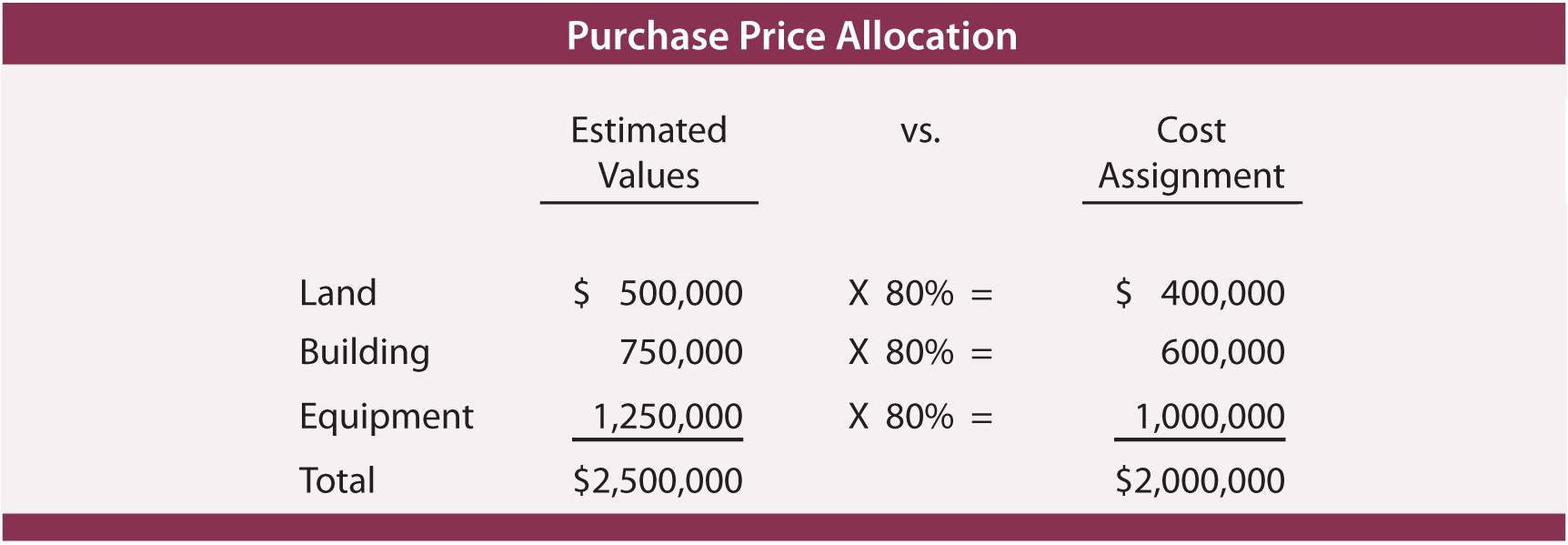
- •Property, Plant, and Equipment
- •Cost assignment
- •Lump-sum acquisition
- •It is important to note that the preceding allocation approach would not be used if the asset package constituted a “business.” Those procedures were briefly addressed in the previous chapter.
- •Judgment
- •Inadequacy -- An economic determinant of service life which is relevant when an asset is no longer fast enough or large enough to fill the competitive and productive needs of a company.
- •Depreciation methods Depreciation Concepts
- •Some important terminology
- •In any discipline, precision is enhanced by adopting terminology that has very specific meaning. Accounting for pp&e is no exception. An exact understanding of the following terms is paramount:
- •The straight-line method
- •The double-declining balance method
Lump-sum acquisition
A company may buy an existing facility consisting of land, buildings, and equipment. The negotiated price is usually a “turnkey” deal for all the components. While the lump-sum purchase price for the package of assets is readily determinable, assigning costs to the individual components can become problematic. Yet, for accounting purposes, it is necessary to allocate the total purchase price to the individual assets acquired. This may require a proportional allocation of the purchase price to the individual components.
To illustrate, assume Dibitanzl acquired a manufacturing facility from Malloy for $2,000,000. Assume that the facility consisted of land, building, and equipment. If Dibitanzl had acquired the land separately, its estimated value would be $500,000. The estimated value of the building is $750,000. Finally, the equipment would cost $1,250,000 if purchased independent of the “package.” The sum of the values of the components comes to $2,500,000 ($500,000 + $750,000 + $1,250,000). Yet, the actual purchase price was only 80% of this amount ($2,500,000 X 80% = $2,000,000). The accounting task is to allocate the actual cost of $2,000,000 to the three separate pieces, as shown by the following:

The above calculations form the basis for the following entry:

It is important to note that the preceding allocation approach would not be used if the asset package constituted a “business.” Those procedures were briefly addressed in the previous chapter.
Judgment
Accounting may seem to be mechanical. However, there is a need for the exercise of judgment. Professional judgment was required to estimate the value of the components for purposes of making the preceding entry. Such judgments are oftentimes an inescapable part of the accounting process. Note that different estimates of value would have caused a different proportion of the $2,000,000 to be assigned to each item. Does the allocation really matter? It is actually very important because the amount assigned to land will not be depreciated. Amounts assigned to building and equipment will be depreciated at different rates. Thus, the future pattern of depreciation expense (and therefore income) will be altered by this initial allocation. Investors pay close attention to income and proper judgment becomes an important element of the accounting process.
materiality
Many expenditures are for long-lived assets of relatively minor value. Examples include trash cans, telephones, and so forth. Should those expenditures be capitalized and depreciated over their useful life? Or, does the cost of record keeping exceed the benefit? Many businesses simply choose to expense small costs as incurred. The reason is materiality; no matter which way one accounts for the cost, it is not apt to bear on anyone’s decision-making process about the company. This again highlights the degree to which professional judgment comes into play in the accounting process.
Service Life and Cost Allocation
Casually, people will speak of depreciation as a decline in value or “using-up” of an asset. However, in accounting jargon, the term is meant to refer to the allocation of an asset’s cost to the accounting periods benefited. It is not an attempt to value the asset. Thus, it is often said that depreciation is a process of “allocation” not “valuation.” Once an asset’s cost is determined, it next becomes necessary to determine the accounting periods benefited (i.e., service life).
Determining the service life of an asset is an essential first step in calculating the amount of depreciation attributable to a specific period. Several factors must be considered:
Physical deterioration -- “Wear and tear” will eventually cause most assets to simply wear out and become useless. Thus, physical deterioration serves to establish an outer limit on the service life of an asset.
Obsolescence -- The shortening of service life due to technological advances that cause an asset to become out of date and less desirable.
